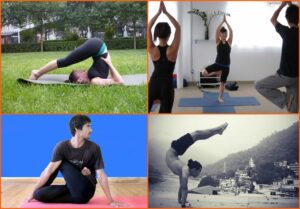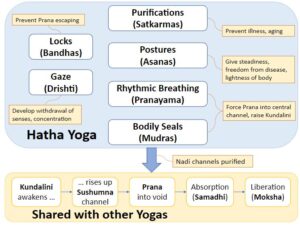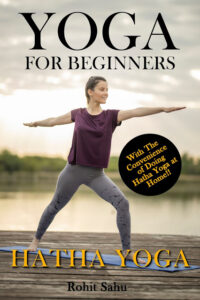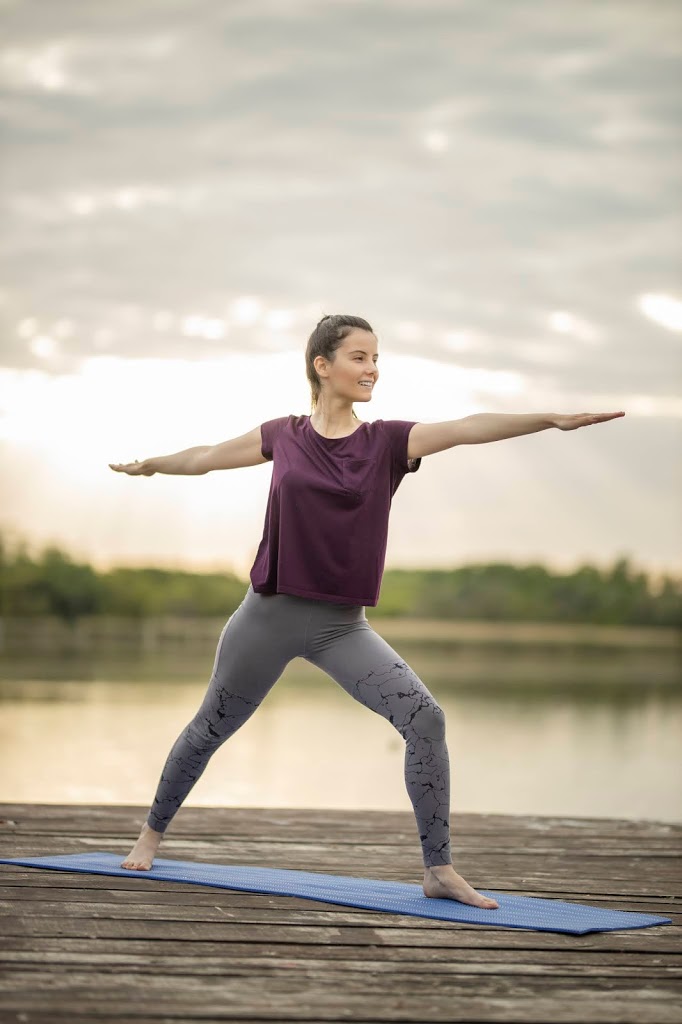Are you looking for a gentle, mindful yoga practice? Do you want to enhance mental tranquility, physical health, and divine influence? Do you want to fill your life with strength, courage, flexibility, peace, opulence, balance, and perfection? Are you looking to balance, harmonize, and unite the two fundamental energies in your system, your solar and the lunar energies? If so, Hatha Yoga is what you need.
Hatha is a general category that includes most styles of yoga. It is an old system that includes the practice of Asanas (yoga postures) and Pranayamas (breathing techniques), which help bring peace to mind and body and prepares the body for deeper spiritual practices such as meditation. It emphasizes the cultivation of the body as a way of attaining a state of spiritual purity in which the mind is removed from external objects.
In India, Hatha Yoga in popular tradition is associated with the Yogis of Natha Sampradaya through its traditional founder, Matsyendranath. Almost all hathayogic texts belong to the Nath Siddhas, and the important ones are attributed to the disciples of Matsyendranath, Gorakhnath or Gorakshanath.
Hatha Yoga, once considered to be the mother of all other forms, is now seen in the West as their sibling. All the forms of yoga that you know—Iyengar, Ashtanga, Vinyasa, Kundalini, Power, Sivananda, Yin, Viniyoga, Restorative, Moksha, Kripalu, Forrest, Jivamukti, Anusara, and Bikram—come from what was once a full-life path and moral code called Hatha Yoga. But in today’s world, Hatha Yoga is just another form of yoga.
Hatha Yoga is a preparatory process of yoga. The word “Ha” means the sun, the word “Ta” means the moon. “Hatha” means a yoga that brings the equilibrium between the sun and the moon within you, or Pingala and Ida within you. You can pursue Hatha Yoga in ways that carry you beyond certain limits, but essentially, it’s a physical preparation—preparing the body for a higher possibility.
Hatha Yoga has become a popular form of exercise in many parts of the world. Its easy accessibility and emphasis on health and well-being have made it play an important role in counteracting the many harmful impacts of a rapidly changing world.
Hatha Yoga has grown in popularity in the West as an exercise that improves strength,endurance, relaxation, and focus of mind. It offers an opportunity to stretch, unwind, and reduce stress, offering a strong counterpoint to both busy lives and aerobic exercises. As with any other yoga practice, it can be done by anyone, regardless of sexuality, race, class, or creed.
Training involves breath, body, and mind, and sessions typically require 45-90 minutes of breathing, yoga poses, and meditation.
A typical Hatha Yoga class comprises the following parts:
1. Pranayamas
2. Sun Salutations
3. Asanas
4. Savasana
5. Meditation
Pranayama: Pranayama translates to ‘extension of life force.’ ‘Prana’ means life energy or breath, and ‘Ayama’ means to extend. Pranayama practice prolongs the life within us and awakens our Kundalini energy.
Pranayama comprises controlled breathing techniques that have a direct impact on your nervous system and the energy of your body’s life force. You would be introduced to deep breathing techniques and possibly some breathing exercises to stimulate or relax your mind and body, depending on the nature or time of the class.
Sun Salutation: Several Hatha classes use Sun Salutations to warm up the body and build up heat within. Sun Salutation is a flow of yoga asanas linked with breathing. They are incredibly energizing, and integrating the inhalation and exhalation with each transition generates a moving meditation, promoting stillness and concentration in the mind.
Asanas: You’ll be guided by standing postures, core work, balancing postures, backbends, inversions, and floor poses. The layout of the session is organized in a standardized manner to make it easier for you to get the best out of each pose. Poses vary in complexity from lying flat on the floor to physically demanding positions.

Savasana: Or Corpse Pose, is everyone’s favorite. This final pose requires you to lie on your back with your arms and legs apart, like a starfish, and to let go fully.
Savasana is an important part of the yoga class which gives the body and mind time to rejuvenate and absorb all the positive work you have done with your body.
You will usually lie here for 5-10 minutes, with your eyes closed and your body heavy on the floor. Breathing deeply in Savasana helps you to relieve stress in your body and to wake up feeling energized and nourished.
Being mindful of your breath makes it easier for your mind to stay in the current moment and to help create the framework for sitting meditation.
Meditation: The bulk of Hatha Yoga classes conclude with a brief duration of meditation. During this time of peaceful relaxation, you sit in Sukhasana or Lotus Pose and enjoy a relaxing meditation.
The standard Hatha Yoga class ends with participants putting their hands together in a praying posture over their hearts, bowing and saying Namaste to each other and thanking God.
Who Can Perform It?
1. Do you want to enhance mental tranquility, physical health, and divine influence?
2. Are you looking to strengthen your core muscles and strength?
3. Are you looking for a gentle, mindful yoga practice?
4. Do you want to get a better night’s sleep?
5. Do you want to fill your life with strength, courage, flexibility, peace, opulence, balance, and perfection?
6. Are you looking to balance, harmonize, and unite the two fundamental energies in your system, your solar and the lunar energies?
7. Do you want to improve depression symptoms?
8. Are you looking for a permanent solution to your stress?
9. Do you want to lose weight?
10. Is your lifestyle messed up and you want to develop discipline and self-control?
11. Are you looking for a way to prepare the body for meditation?
12. Do you want to enhance the quality of Prana?
13. Do you want to advance your spiritual growth?
14. Do you want to attain overall well-being?
If you replied “YES” to any of these issues, you should perform Hatha Yoga. It will offer optimistic, loving energy that will spread across the universe. You will naturally attain a composition of health, joy, bliss, and above all, balance; an entire universe of joy-filled opportunities will open up to you.
Hatha Yoga Benefits
1. Improves Cardiac Health
2. Helps develop Discipline and Self-Control
3. Prepares the Body for Meditation
6. Decreases Anxiety and Stress
7. Results in Healthy Glowing Skin
8. Improves Joint Flexibility and Mobility
11. Relaxes the Mind and Releases the Stress in the Body
12. You develop an Optimistic Attitude
13. Helps with Weight Loss
14. Results in a Calmer and Happier Mind
15. Helps in Kundalini Awakening

Some Beginners Tips
1. Always practice after taking a shower and empty your bladder and bowels.
2. Never practice on a full stomach.
3. Always listen to your body. The beauty of yoga is that if anything doesn’t feel right, it’s fine to get out of it. There’s no “no pain, no gain” attitude here. It’s OK not to go to the full expression of the pose, because where you are, as long as you have the correct posture, it’s beneficial. What you want to do is go to the “edge”—where you experience sensation, but not pain.
4. Do not eat the food right after yoga. There should be a gap of at least 20-30 minutes between the practice and the meal.
5. You must not hold your breath until you are clearly instructed to do so. And always breathe from the nostrils unless otherwise instructed.
6. If you’re in a class, don’t compare your practice with that of another student, or even a coach. Or also your own (because your body varies day-to-day-sometimes in the same pose from one side to the other). Focus on your practice, your breath, on what the teacher tells you. Competition can rid you of the enjoyment of your practice and will make you attempt positions that your body is not ready for.
7. Those just starting Hatha Yoga practices often report exhaustion and soreness in the body, as yoga stretches and exercises muscles and tendons that are sometimes long-neglected. Some yogic breathing and mediation methods can be challenging for beginners and can induce dizziness or disorientation. Whenever this occurs, just relax and keep going as per your will. Overtime, exhaustion and soreness will be gone and you will be able to perform the various practices seamlessly. 8. If you feel weak during asanas, drink a small amount of honey in lukewarm water.
To learn more about Hatha Yoga, consider reading my book, Yoga For Beginners: Hatha Yoga

This Hatha yoga guide is perfect for beginners and those of you looking for a more mindful practice. It will strengthen and stretch the body, keeping each pose for several breaths. Hatha yoga appears to be gentler and slower than a Vinyasa or Power style class. If you’re new to yoga, recovering from injury, or looking to relax by moving gently and thoughtfully, this yoga form might be the best fit for you.
All you’ve got to do is show up. When you decide to take care of yourself, all kinds of good things begin to happen. You’ll have more energy. You’ll become relaxed. Your attitude to life will turn more optimistic.
Hatha yoga rituals, including asana, pranayama, mudras, and mantras, cultivate strong energies to promote improvement both mentally and physically. They will change the way you feel in your soul and body.
In this guide, you’ll discover:
✔️Science Behind Hatha Yoga
✔️Who Can Perform It
✔️Benefits
✔️Things You Need to Know Before Starting
✔️Hatha Yoga Mantras, Mudras, Pranayamas, and Asanas
✔️Hatha Yoga Meditation
✔️Beginner’s Common Mistakes and How to Fix Them
✔️Common Myths and FAQs
So, are you interested in learning all about how Hatha Yoga can benefit you? This is a comprehensive guide to take a closer look at what this gentle and slow-paced yoga style can do for you and how you can master it for your overall well-being.
Covering the fundamentals of each practice in depth, and how to correct the most common errors, this Hatha Yoga Guide has left nothing to help you attain mental, spiritual, and physical well-being.




